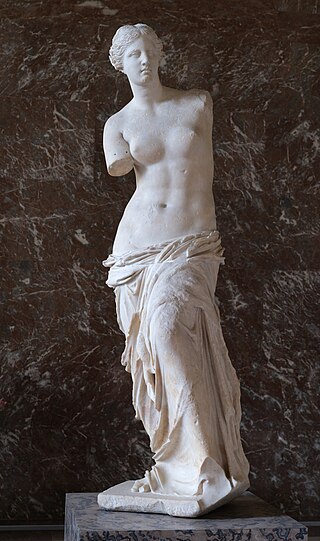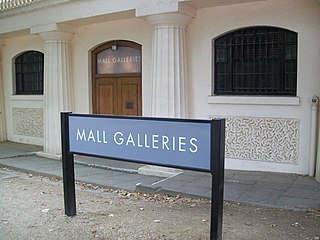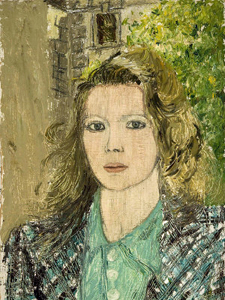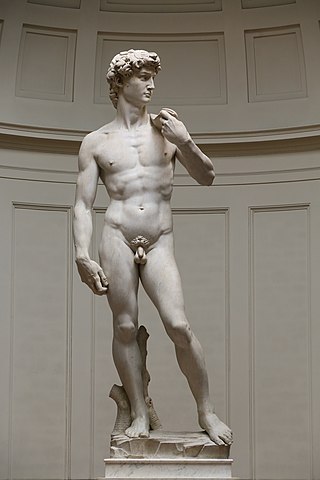| Portrait of Ms Ruby May, Standing | |
|---|---|
 | |
| Artist | Leena McCall |
| Year | 2012 |
| Medium | Oil on canvas |
Portrait of Ms Ruby May, Standing is an oil on canvas painting made in 2012 by the British visual artist Leena McCall, portraying her friend Ruby May. [1]
| Portrait of Ms Ruby May, Standing | |
|---|---|
 | |
| Artist | Leena McCall |
| Year | 2012 |
| Medium | Oil on canvas |
Portrait of Ms Ruby May, Standing is an oil on canvas painting made in 2012 by the British visual artist Leena McCall, portraying her friend Ruby May. [1]
The painting depicts May, a tattooed black-haired woman, smoking a pipe. May is coolly scrutinizing the viewer, her other hand on her hip, with her trousers unbuttoned such that her pubic hair is visible. McCall's intention in painting May was to explore "how women choose to express their sexual identity beyond the male gaze". [2]
The painting received public attention after the Mall Galleries removed it from the Society of Women Artists's annual exhibition in 2014, after which it was replaced with another nude portrait. According to a statement by the Galleries, this was done because of "a number of complaints regarding the depiction of the subject and taking account of its location en route for children to our learning centre", and, according to McCall, because the painting had been deemed "disgusting" and "pornographic". Writing in The Guardian , Rowan Pelling interpreted this reaction as implying that "the minute a woman is alive and free to move, an active agent of her own sexuality, she is a menace to society", whereas Mall Galleries viewers appeared to feel more comfortable with a nude woman who is a "more passive and unthreatening recipient of the wandering viewer's gaze". [3] In response to the removal of the work, McCall started a Twitter campaign with the hashtag #eroticcensorship. [1]

Édouard Manet was a French modernist painter. He was one of the first 19th-century artists to paint modern life, as well as a pivotal figure in the transition from Realism to Impressionism.

Pubic hair is terminal body hair that is found in the genital area of adolescent and adult humans. The hair is located on and around the sex organs and sometimes at the top of the inside of the thighs. In the pubic region around the pubis bone and the mons pubis that covers it, it is known as a pubic patch. Pubic hair is also found on the scrotum and base of the penile shaft in males and on the vulva in females.

Erotic art is a broad field of the visual arts that includes any artistic work intended to evoke arousal. It usually depicts human nudity or sexual activity, and has included works in various visual mediums, including drawings, engravings, films, paintings, photographs, and sculptures. Some of the earliest known works of art include erotic themes, which have recurred with varying prominence in different societies throughout history. However, it has also been widely considered taboo, with either social norms or laws restricting its creation, distribution, and possession. This is particularly the case when it is deemed pornographic, immoral, or obscene.

Le Déjeuner sur l'herbe – originally titled Le Bain – is a large oil on canvas painting by Édouard Manet created in 1862 and 1863.

Olympia is a 1863 oil painting by Édouard Manet, depicting a nude white woman ("Olympia") lying on a bed being attended to by a black maid. The French government acquired the painting in 1890 after a public subscription organized by Claude Monet. The painting is now in the Musée d'Orsay, Paris.

Alice Neel was an American visual artist. Recognized for her paintings of friends, family, lovers, poets, artists, and strangers, Neel is considered one of the greatest American portraitists of the 20th century. Her career spanned from the 1920s to 1980s.
Jennifer Anne Saville is a contemporary British painter and an original member of the Young British Artists. Saville works and lives in Oxford, England and she is known for her large-scale painted depictions of nude women. Saville has been credited with originating a new and challenging method of painting the female nude and reinventing figure painting for contemporary art. Some paintings are of small dimensions, while other are of much larger scale. Monumental subjects come from pathology textbooks that she has studied that informed her on injury to bruise, burns, and deformity. John Gray commented: "As I see it, Jenny Saville's work expresses a parallel project of reclaiming the body from personality. Saville worked with many models who underwent cosmetic surgery to reshape a portion of their body. In doing that, she captures "marks of personality for the flesh" and together embraces how we can be the writers of our own lives."

The Rokeby Venus is a painting by Diego Velázquez, the leading artist of the Spanish Golden Age. Completed between 1647 and 1651, and probably painted during the artist's visit to Italy, the work depicts the goddess Venus in a sensual pose, laying on a bed with her back facing the viewer, and looking into a mirror held by the Roman god of physical love, her son Cupid. The painting is in the National Gallery, London.

The Naked Maja or The Nude Maja is an oil-on-canvas painting made around 1797–1800 by the Spanish artist Francisco de Goya, and is now in the Museo del Prado in Madrid. It portrays a nude woman reclining on a bed of pillows, and was probably commissioned by Manuel de Godoy, to hang in his private collection in a separate cabinet reserved for nude paintings. Goya created a pendant of the same woman identically posed, but clothed, known today as La maja vestida, also in the Prado, and usually hung next to La maja desnuda. The subject is identified as a maja or fashionable lower-class Madrid woman, based on her costume in La maja vestida.

Depictions of nudity include all of the representations or portrayals of the unclothed human body in visual media. In a picture-making civilization, pictorial conventions continually reaffirm what is natural in human appearance, which is part of socialization. In Western societies, the contexts for depictions of nudity include information, art and pornography. Information includes both science and education. Any ambiguous image not easily fitting into one of these categories may be misinterpreted, leading to disputes. The most contentious disputes are between fine art and erotic images, which define the legal distinction of which images are permitted or prohibited.

The Federation of British Artists (FBA) consists of nine art societies, and is based at Mall Galleries in London where the societies' Annual Exhibitions are held. The societies represent living artists working in the United Kingdom who create contemporary figurative art. Mall Galleries aim to 'promote, inspire and educate audiences about the visual arts.'

Mickalene Thomas is a contemporary African-American visual artist best known as a painter of complex works using rhinestones, acrylic, and enamel. Thomas's collage work is inspired from popular art histories and movements, including Impressionism, Cubism, Dada, the Harlem Renaissance, and selected works by the Afro-British painter Chris Ofili. Her work draws from Western art history, pop art, and visual culture to examine ideas around femininity, beauty, race, sexuality, and gender.

Sylvia Sleigh was a Welsh-born naturalised American realist painter who lived and worked in New York City. She is known for her role in the feminist art movement and especially for reversing traditional gender roles in her paintings of nude men, often using conventional female poses from historical paintings by male artists like Diego Vélazquez, Titian, and Jean-Auguste-Dominique Ingres. Her most well-known subjects were art critics, feminist artists, and her husband, Lawrence Alloway.
Émilie Charmy was an artist in France's early avant-garde. She worked closely with Fauve artists like Henri Matisse, and was active in exhibiting her artworks in Paris, particularly with Berthe Weill.

The nude, as a form of visual art that focuses on the unclothed human figure, is an enduring tradition in Western art. It was a preoccupation of Ancient Greek art, and after a semi-dormant period in the Middle Ages returned to a central position with the Renaissance. Unclothed figures often also play a part in other types of art, such as history painting, including allegorical and religious art, portraiture, or the decorative arts. From prehistory to the earliest civilizations, nude female figures were generally understood to be symbols of fertility or well-being.
Hope I is an oil painting created by Gustav Klimt in 1903. It is 189 cm x 67 cm and currently located in the National Gallery of Canada, Ottawa. The main subject of this work is a pregnant, nude female. She is holding her hands together above her stomach and close to her chest. She gazes directly at the viewer and has a great mass of hair with a crown of forget-me-not flowers placed on her head. The scene is beautiful upon first glance but once the viewer's eyes move to the background, deathlike figures become noticeably present.

After the Bath, Woman Drying Herself is a pastel drawing by Edgar Degas, made between 1890 and 1895. Since 1959, it has been in the collection of the National Gallery, London. This work is one in a series of pastels and oils that Degas created depicting female nudes. Originally, Degas exhibited his works at Impressionist exhibitions in Paris, where he gained a loyal following.

Candaules, King of Lydia, Shews his Wife by Stealth to Gyges, One of his Ministers, as She Goes to Bed, rarely known as The Imprudence of Candaules, is a 45.1 by 55.9 cm oil painting on canvas by English artist William Etty, first exhibited at the Royal Academy in 1830. It shows a scene from the Histories by Herodotus, in which Candaules, king of Lydia, invites his bodyguard Gyges to hide in the couple's bedroom and watch his wife Nyssia undress, to prove to him her beauty. Nyssia notices Gyges spying and challenges him to either accept his own execution or to kill Candaules as a punishment. Gyges chooses to kill Candaules and take his place as king. The painting shows the moment at which Nyssia, still unaware that she is being watched by anyone other than her husband, removes the last of her clothes.
Lilith is an 1887 painting by English artist John Collier, who worked in the style of the Pre-Raphaelite Brotherhood. The painting of the Jewish mythic figure Lilith is held in the Atkinson Art Gallery in Southport, England. It was transferred from Bootle Art Gallery in the 1970s.

Le Repos is an oil-on-canvas painting created by Pablo Picasso in 1932. It depicts a portrait of Marie-Thérèse Walter, the artist's lover and muse, in a sleeping pose. The painting was produced in the midst of their relationship and is a demonstration of Picasso's love for his mistress. Le Repos was one of a series of sleeping portraits of Walter that Picasso created in 1932. On 14 May 2018, the painting achieved a value of $36.9 million when it was sold at Sotheby's auction.